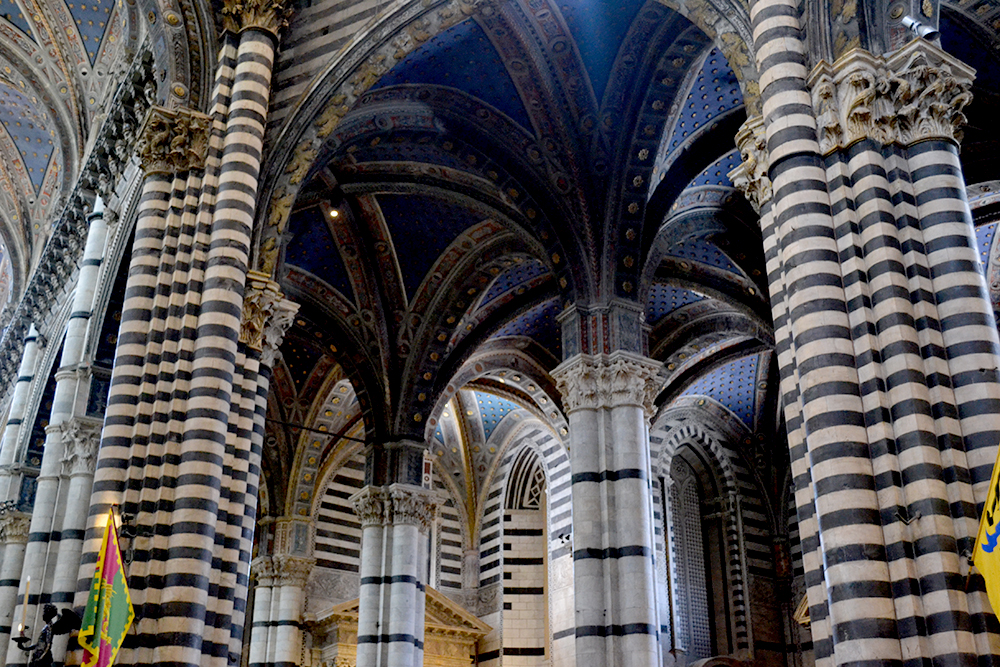 I loved the arches I saw in Florence, especially those that rise out of the columns and spread out geometrically at the ceiling. And, the gray and white stripes, WOW! See the photos of my favorite interior at the Cathedral in Siena (above). Were the stripes meant to be decorative? The Santa Maria Novella and the Santa Trinita Churches in Florence (see photos below) also had gray and white stripes on their columns in certain areas, but neither one of them were quite so pronounced as the Siena Cathedral.
I loved the arches I saw in Florence, especially those that rise out of the columns and spread out geometrically at the ceiling. And, the gray and white stripes, WOW! See the photos of my favorite interior at the Cathedral in Siena (above). Were the stripes meant to be decorative? The Santa Maria Novella and the Santa Trinita Churches in Florence (see photos below) also had gray and white stripes on their columns in certain areas, but neither one of them were quite so pronounced as the Siena Cathedral.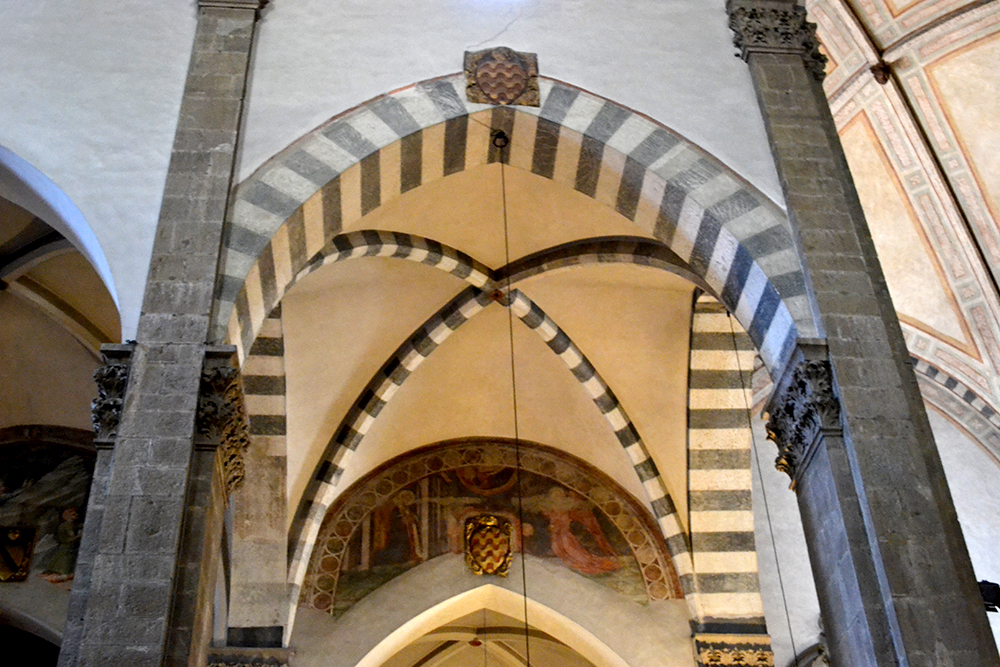
 After enjoying these gray and white stripes in the Florence churches, I realized there must be a pattern (no pun intended), so I looked it up.
After enjoying these gray and white stripes in the Florence churches, I realized there must be a pattern (no pun intended), so I looked it up.
Here's what I found out.
It seems the Italian Gothic style of architecture used different shades of stone to exaggerate the buildings’ breadth — an early example of how they used stripes to manipulate architectural appearances. There was also a practical reason for the stripes. Alternating layers of brick and stone were often used to reinforce the wall structure, by tying the outer skin of the wall to its interior (often brick) fill. This method had other advantages, too: when quality stone was scarce or expensive, it could be selectively introduced between bands of inferior material (brick or stone) to strengthen the wall. And, while this composite construction may be grounded in principles of structure and economy, its decorative effect cannot be ignored. This may explain the medieval Italian use of stripes over entire building surfaces.
[caption id="attachment_375" align="aligncenter" width="500"]
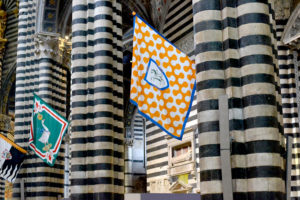
The stripes are not painted, they are composed of different layers of stone.[/caption]
Stripes evoke an interesting reaction.
Another interesting twist to the use of stripes is their deceptive connotation, which is why they went out of style in architecture after awhile. Sometimes you see stripes in Renaissance clothing. Even today, most of us today still associate stripes with a strong sense of marginality, fraudulence and deception. And, while the sentiments attributed to striped surfaces have oscillated significantly over many centuries,
Pastoureau* notes that stripes never entirely lost their connection to deception. This can be witnessed even today in the familiar representations of clowns, tricksters and criminals in striped attire.
*Michel Pastoureau, The Devil’s Cloth: A History of Stripes
In this setting, I think they are beautiful!
 What do those balls represent? Why was the crest designed the way it was?
According to one theory, (and there are many), the armorial bearings of the Medici supposedly represent pills, because medici in Italian means "physicians." Another more plausible explanation is that the Medici adopted the round balls because those symbols were associated in the public mind with money lending and credit. The Medici family was very influential in their time. During my stay in Italy, I saw their coat of arms displayed all over Florence and other Tuscan cities.
A logo is meant to be consistent and lasting (especially if it is cast in stone!) But the mission or legacy behind a logo or "coat of arms" goes much deeper. It will represent everything you do, who you are, why you do what you do, how you act and what you produce.
What do those balls represent? Why was the crest designed the way it was?
According to one theory, (and there are many), the armorial bearings of the Medici supposedly represent pills, because medici in Italian means "physicians." Another more plausible explanation is that the Medici adopted the round balls because those symbols were associated in the public mind with money lending and credit. The Medici family was very influential in their time. During my stay in Italy, I saw their coat of arms displayed all over Florence and other Tuscan cities.
A logo is meant to be consistent and lasting (especially if it is cast in stone!) But the mission or legacy behind a logo or "coat of arms" goes much deeper. It will represent everything you do, who you are, why you do what you do, how you act and what you produce.


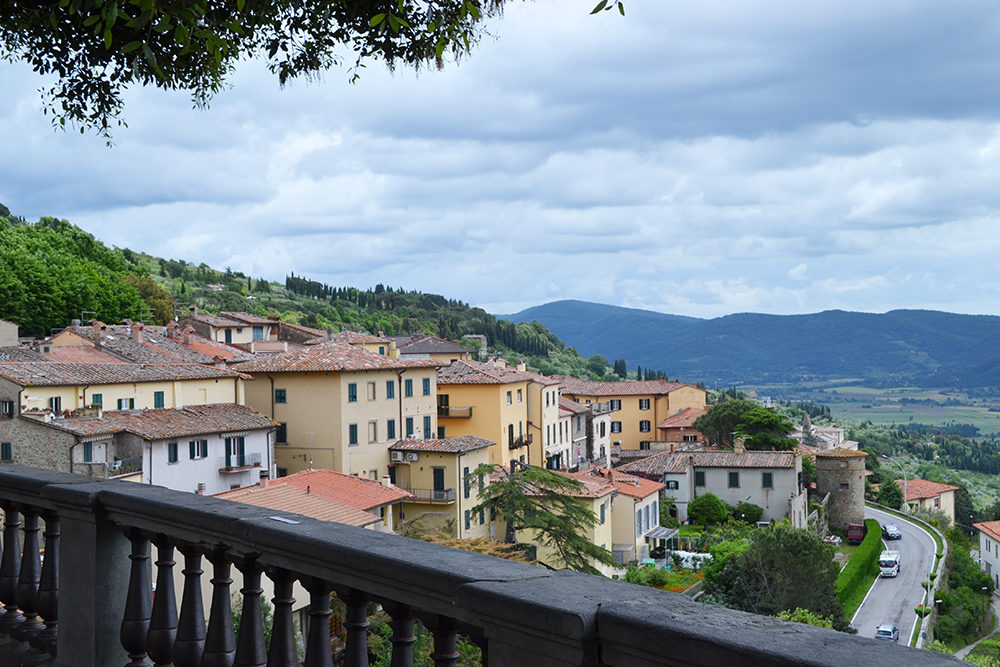
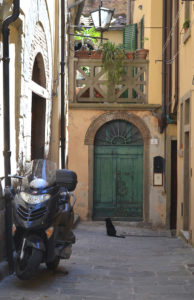 Cortona is a Tuscan village in Italy where my fellow workshop participants and I spent 4 days painting (May 2016), exploring the ancient history, and feasting on the food… It was incredibly enjoyable, as was the charm of the narrow cobblestone streets and clay tiled roofs.
The drive up to the town was a long ascent via winding roads culminating in a breathtaking view over the vast valley below. Imagine my surprise when I first pushed open my hotel room shutters to this amazing view! (Just like in the movie, “A Room with a View” :)
Cortona is a Tuscan village in Italy where my fellow workshop participants and I spent 4 days painting (May 2016), exploring the ancient history, and feasting on the food… It was incredibly enjoyable, as was the charm of the narrow cobblestone streets and clay tiled roofs.
The drive up to the town was a long ascent via winding roads culminating in a breathtaking view over the vast valley below. Imagine my surprise when I first pushed open my hotel room shutters to this amazing view! (Just like in the movie, “A Room with a View” :)
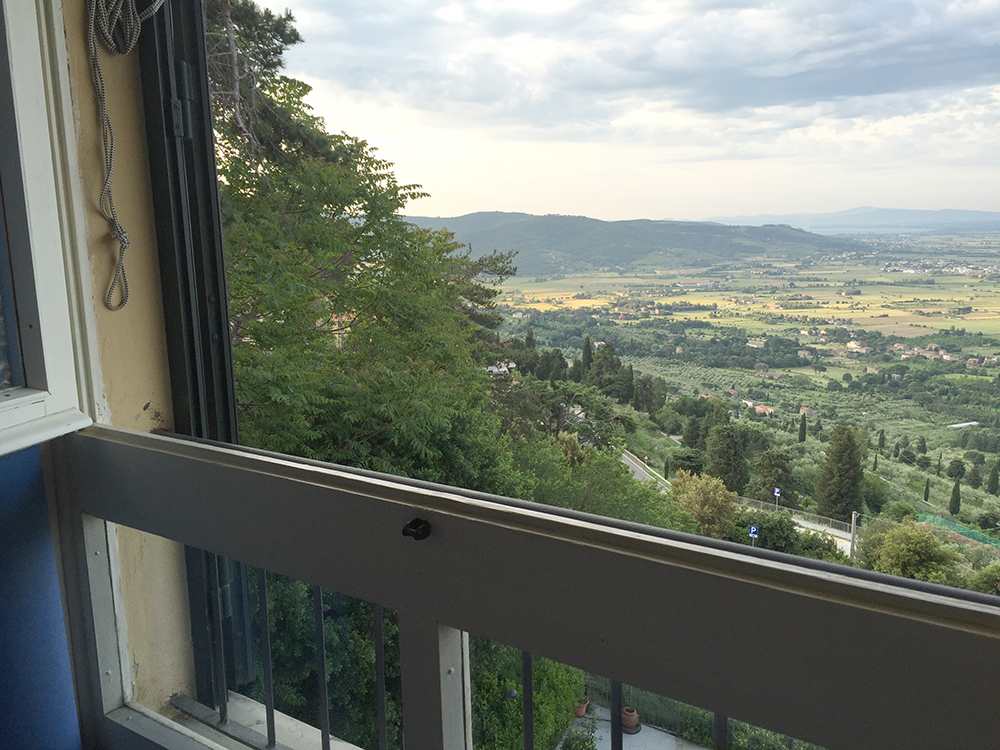
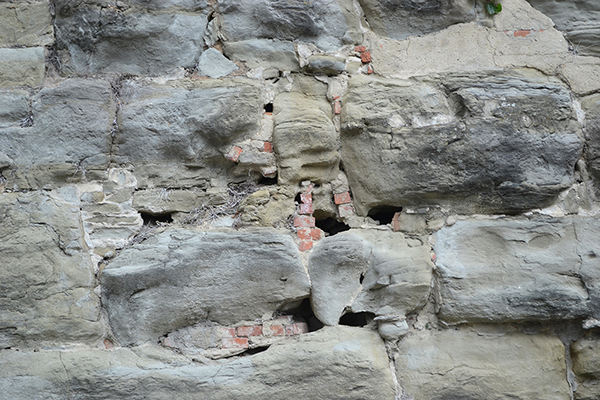
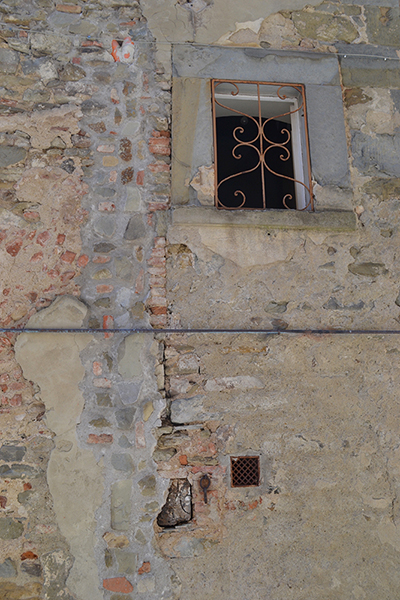
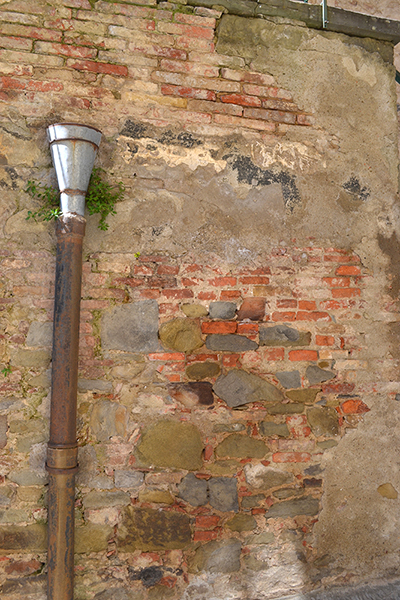
 I loved the arches I saw in Florence, especially those that rise out of the columns and spread out geometrically at the ceiling. And, the gray and white stripes, WOW! See the photos of my favorite interior at the Cathedral in Siena (above). Were the stripes meant to be decorative? The Santa Maria Novella and the Santa Trinita Churches in Florence (see photos below) also had gray and white stripes on their columns in certain areas, but neither one of them were quite so pronounced as the Siena Cathedral.
I loved the arches I saw in Florence, especially those that rise out of the columns and spread out geometrically at the ceiling. And, the gray and white stripes, WOW! See the photos of my favorite interior at the Cathedral in Siena (above). Were the stripes meant to be decorative? The Santa Maria Novella and the Santa Trinita Churches in Florence (see photos below) also had gray and white stripes on their columns in certain areas, but neither one of them were quite so pronounced as the Siena Cathedral.
 After enjoying these gray and white stripes in the Florence churches, I realized there must be a pattern (no pun intended), so I looked it up.
After enjoying these gray and white stripes in the Florence churches, I realized there must be a pattern (no pun intended), so I looked it up.
 The stripes are not painted, they are composed of different layers of stone.[/caption]
Stripes evoke an interesting reaction.
Another interesting twist to the use of stripes is their deceptive connotation, which is why they went out of style in architecture after awhile. Sometimes you see stripes in Renaissance clothing. Even today, most of us today still associate stripes with a strong sense of marginality, fraudulence and deception. And, while the sentiments attributed to striped surfaces have oscillated significantly over many centuries, Pastoureau* notes that stripes never entirely lost their connection to deception. This can be witnessed even today in the familiar representations of clowns, tricksters and criminals in striped attire.
The stripes are not painted, they are composed of different layers of stone.[/caption]
Stripes evoke an interesting reaction.
Another interesting twist to the use of stripes is their deceptive connotation, which is why they went out of style in architecture after awhile. Sometimes you see stripes in Renaissance clothing. Even today, most of us today still associate stripes with a strong sense of marginality, fraudulence and deception. And, while the sentiments attributed to striped surfaces have oscillated significantly over many centuries, Pastoureau* notes that stripes never entirely lost their connection to deception. This can be witnessed even today in the familiar representations of clowns, tricksters and criminals in striped attire.

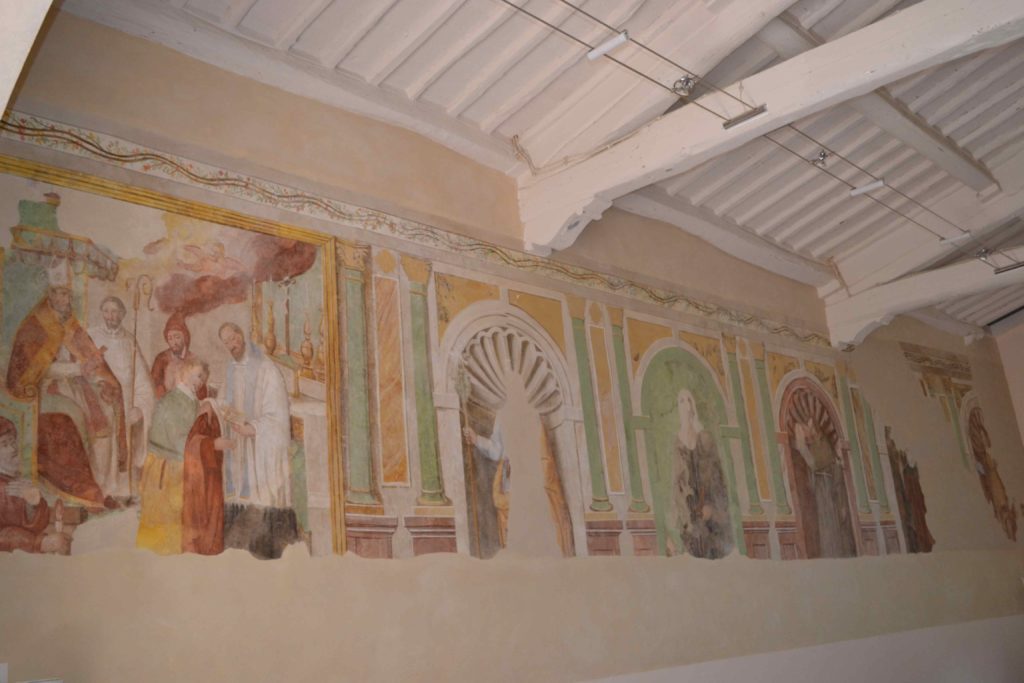 San Fedele, now operating as the Tuscan Renaissance Center, is a vibrant and beautiful venue for people from all over the world to come and share their passions. It was a privilege for me to spend time in the inspiring environment. You can find out more at
San Fedele, now operating as the Tuscan Renaissance Center, is a vibrant and beautiful venue for people from all over the world to come and share their passions. It was a privilege for me to spend time in the inspiring environment. You can find out more at 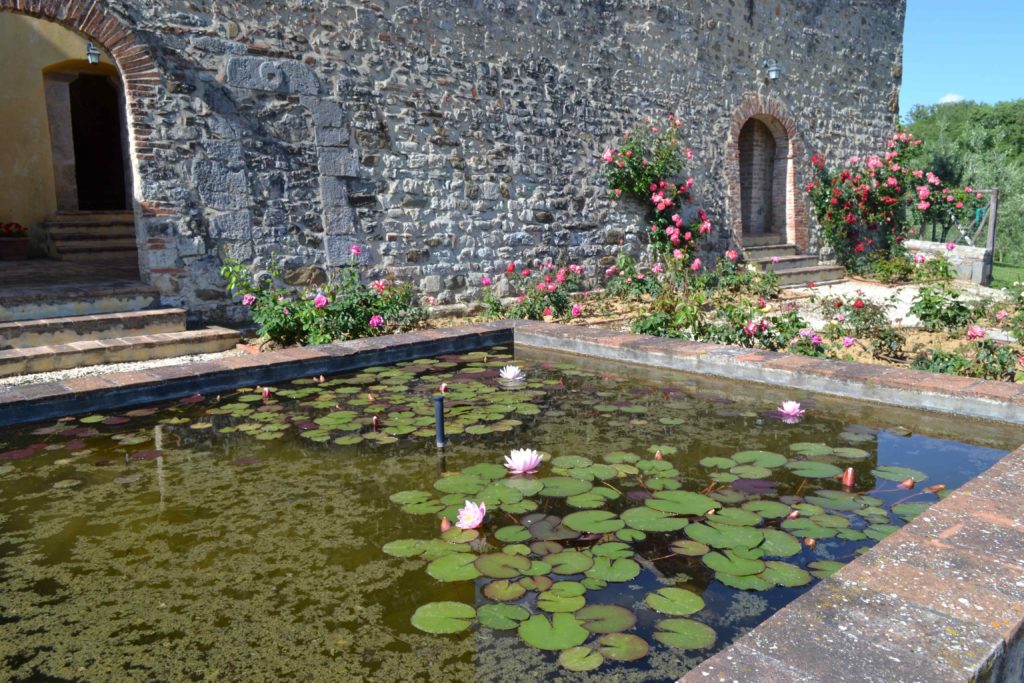
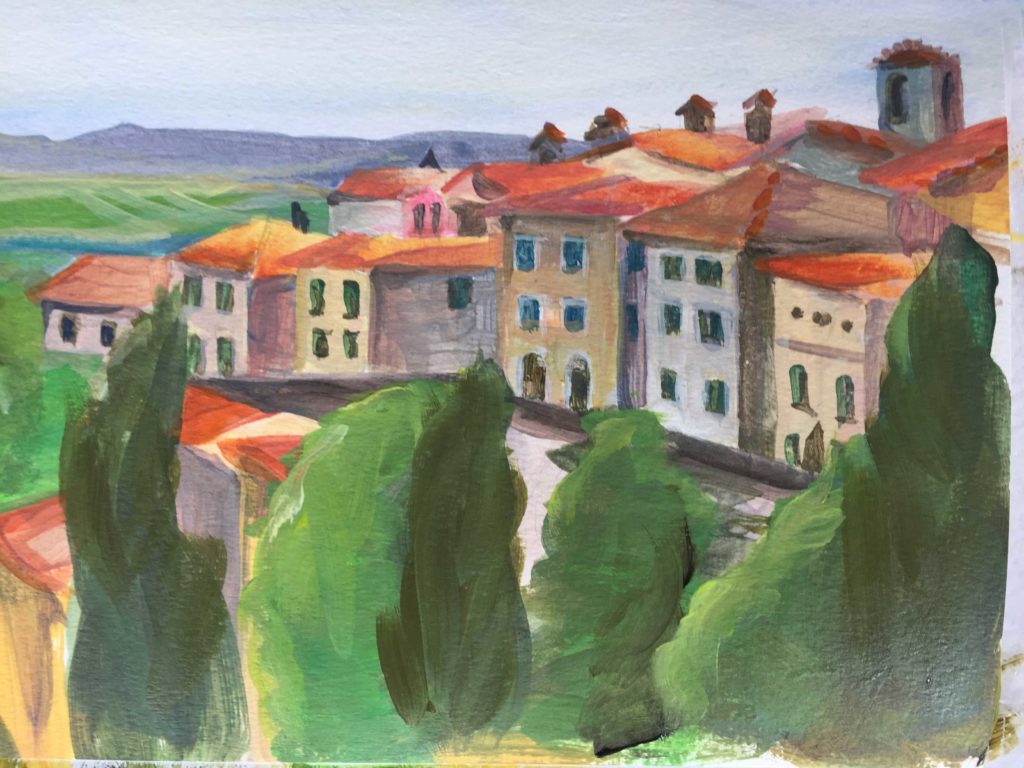 After a day of exploring Cortona, Italy, a fascinating town of history and legends, I chose a beautiful stacked cluster of houses as the scene to paint for my study. It was windy and cool, with occasional heavy showers today, so I worked from a spot inside my hotel, looking out of a meeting room window. Fortunately the sun shone enough for me to capture the rich colors.
Let's face it, I am rusty at this. It's been a while since I've painted regularly. I am determined to stop overworking the paints, and use more confident strokes. Simple, simple, simple....
After a day of exploring Cortona, Italy, a fascinating town of history and legends, I chose a beautiful stacked cluster of houses as the scene to paint for my study. It was windy and cool, with occasional heavy showers today, so I worked from a spot inside my hotel, looking out of a meeting room window. Fortunately the sun shone enough for me to capture the rich colors.
Let's face it, I am rusty at this. It's been a while since I've painted regularly. I am determined to stop overworking the paints, and use more confident strokes. Simple, simple, simple....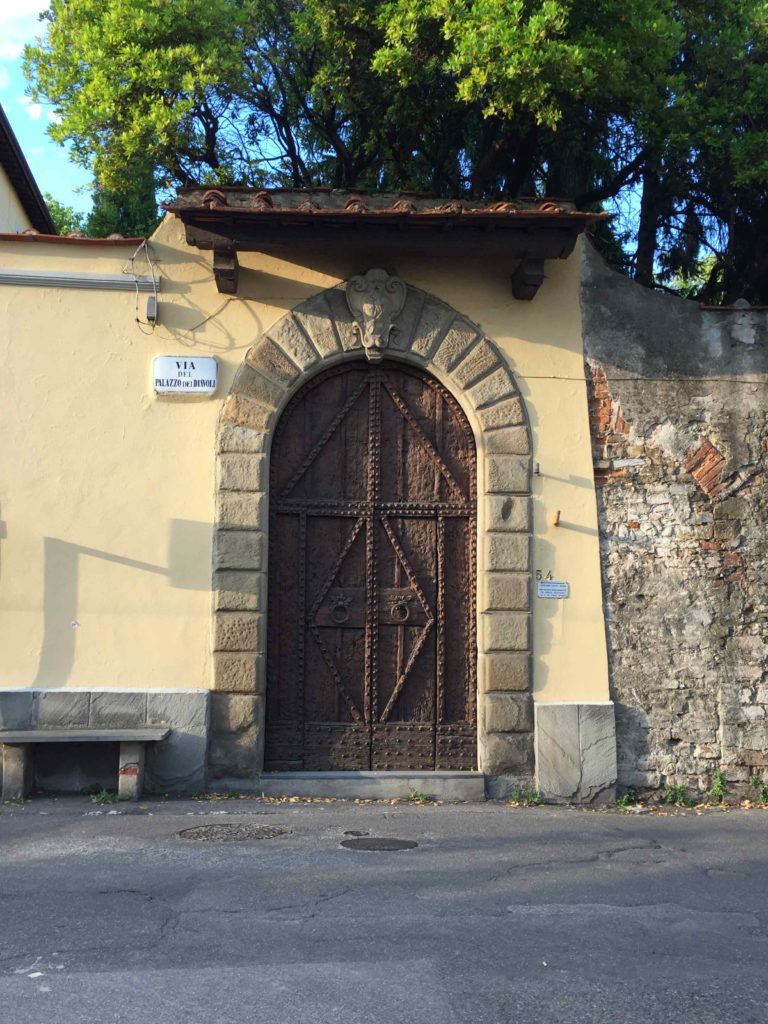 My first day in Florence was entirely focused on becoming acquainted with the neighborhood and getting around. I rented an apartment that is a 15 minute tram ride away from the city center and across the Arno River. I realized that this arched doorway and other beautiful landmarks were becoming a welcome reminder for me to "turn here" to get back to my apartment.
My first day in Florence was entirely focused on becoming acquainted with the neighborhood and getting around. I rented an apartment that is a 15 minute tram ride away from the city center and across the Arno River. I realized that this arched doorway and other beautiful landmarks were becoming a welcome reminder for me to "turn here" to get back to my apartment.
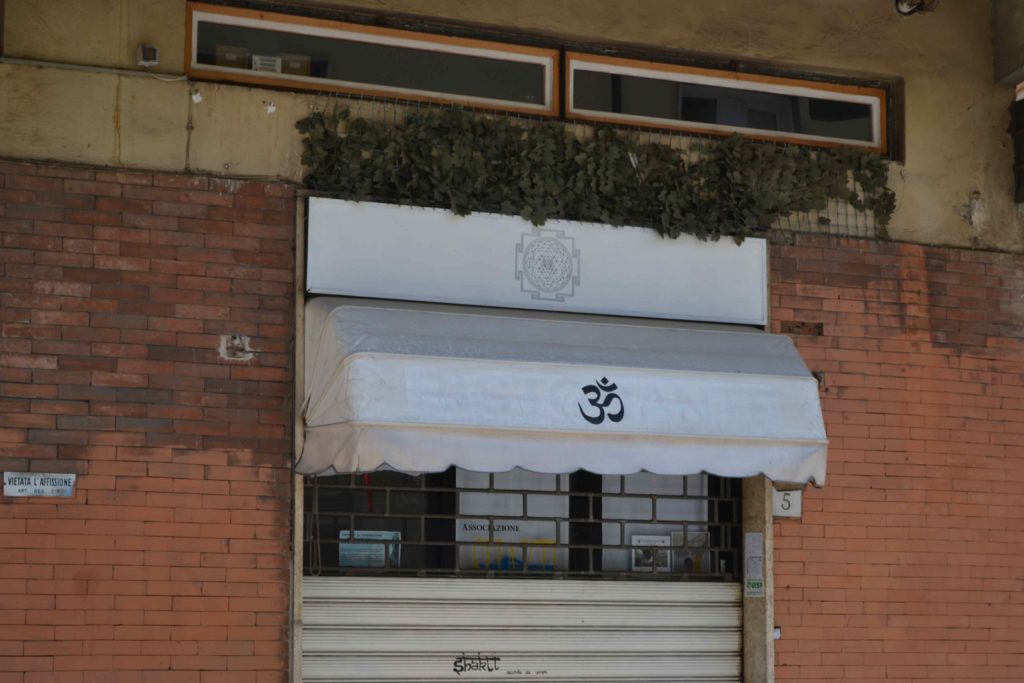 I stopped into this yoga studio, just a few steps away from my apartment in Florence, with the intention of taking a class. The instructor I talked to, (or rather gestered with) didn't speak English, but he said I should come for the Hatha class for 5.5 Euros. As my yoga instructor Bonnie says, yoga is fairly universal so I figured I could manage it ... But, on Friday it was closed, as shown here with its doors pulled down, soooo, I missed that experience. Darn.
I stopped into this yoga studio, just a few steps away from my apartment in Florence, with the intention of taking a class. The instructor I talked to, (or rather gestered with) didn't speak English, but he said I should come for the Hatha class for 5.5 Euros. As my yoga instructor Bonnie says, yoga is fairly universal so I figured I could manage it ... But, on Friday it was closed, as shown here with its doors pulled down, soooo, I missed that experience. Darn.
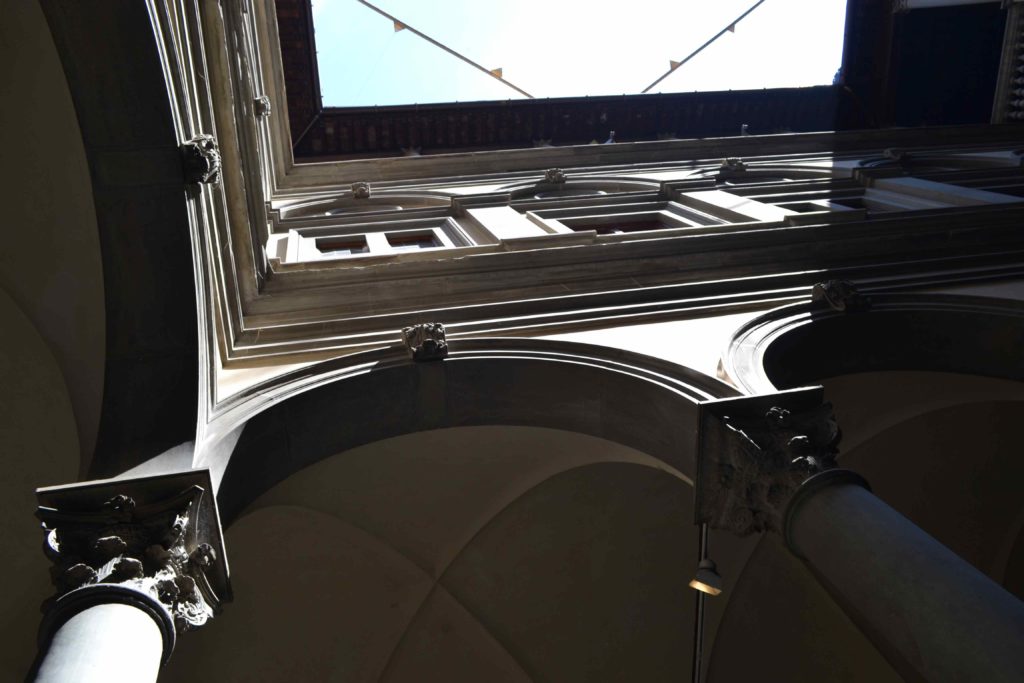 A morning group tour of the Florence city center was a valuable art history adventure. It was interesting to notice the transition from medieval to renaissance styles... less deities and more humanistic.... Striking accomplishments in architecture and wonderful opportunities for photographs.
______
By the end of my second day I have the Tram route down and I can "pretend" to be more like a local. Unlike in the center, most people do not speak English in the neighborhood, and gestures and smiles are the best way to communicate if I need to buy groceries!
A morning group tour of the Florence city center was a valuable art history adventure. It was interesting to notice the transition from medieval to renaissance styles... less deities and more humanistic.... Striking accomplishments in architecture and wonderful opportunities for photographs.
______
By the end of my second day I have the Tram route down and I can "pretend" to be more like a local. Unlike in the center, most people do not speak English in the neighborhood, and gestures and smiles are the best way to communicate if I need to buy groceries!
